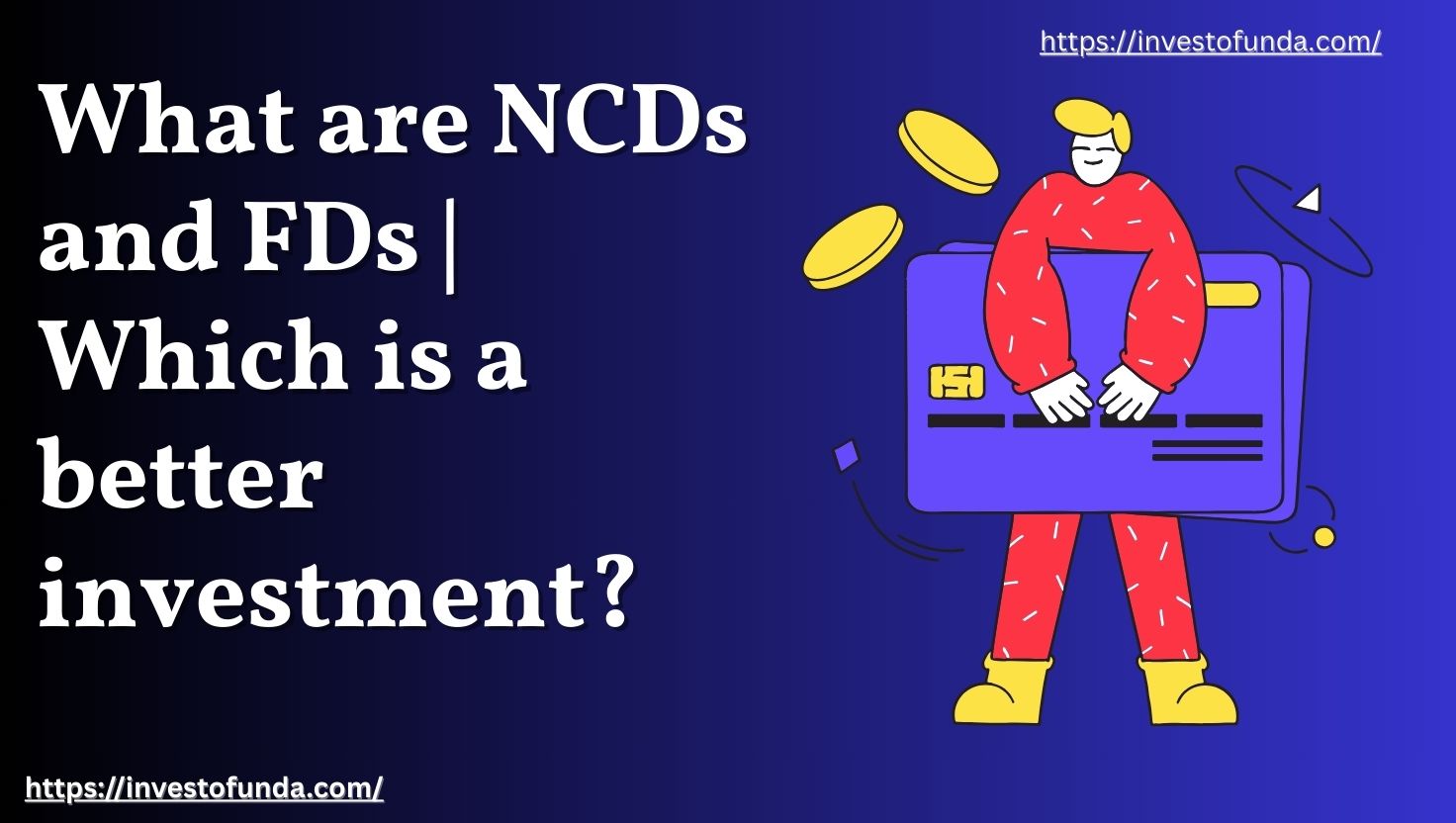What are NCDs and FDs | Which is a better investment?
Non-Convertible Debentures (NCDs) vs. Fixed Deposits (FDs): Which is a Better Investment?
Investors looking for fixed-income options often compare Non-Convertible Debentures (NCDs) and Fixed Deposits (FDs). Both offer stable returns but differ in risk, returns, liquidity, and tax implications.
This detailed 2000+ word guide will compare NCDs vs. FDs on:
✅ Key Differences (Definition, Issuers, Returns)
✅ Risk & Safety (Default Risk, Credit Ratings)
✅ Returns & Interest Rates (NCDs vs. Bank FDs vs. Corporate FDs)
✅ Liquidity & Tenure (Premature Withdrawal, Lock-in)
✅ Taxation (TDS, Capital Gains)
✅ Who Should Invest? (Best for Conservative vs. High-Risk Investors)
1. What are NCDs and FDs?
A. Non-Convertible Debentures (NCDs)
-
Definition: Debt instruments issued by companies (not banks) to raise capital.
-
Convertibility: Cannot be converted into equity (unlike convertible debentures).
-
Issuers: Corporates (Tata Capital, L&T Finance, Shriram Transport).
-
Interest Payout: Monthly, quarterly, or cumulative.
-
Tenure: 1–10 years.
B. Fixed Deposits (FDs)
-
Definition: Bank/corporate deposits offering fixed interest rates.
-
Issuers: Banks (SBI, HDFC) or NBFCs (Bajaj Finance, Mahindra Finance).
-
Interest Payout: Monthly, quarterly, or at maturity.
-
Tenure: 7 days–10 years.
2. Key Differences Between NCDs and FDs
| Parameter | Non-Convertible Debentures (NCDs) | Fixed Deposits (FDs) |
|---|---|---|
| Issuer | Private companies, NBFCs | Banks, corporate FDs |
| Returns | 8%–12% p.a. | 5%–8.5% p.a. |
| Risk Level | Moderate to High (depends on issuer rating) | Low (bank FDs insured up to ₹5L) |
| Liquidity | Listed on stock exchanges (can sell) | Premature withdrawal penalty |
| Taxation | Interest taxable (TDS @10%) | Interest taxable (TDS @10%) |
| Tenure | 1–10 years | 7 days–10 years |
3. Risk & Safety Comparison
A. Credit Risk
-
NCDs:
-
Dependent on company’s financial health.
-
Check credit ratings (AAA, AA+, A – CRISIL, ICRA).
-
Example: AAA-rated NCDs (low risk) vs. A-rated (higher risk).
-
-
FDs:
-
Bank FDs: Insured up to ₹5 lakh (DICGC guarantee).
-
Corporate FDs: Higher risk than banks (no insurance).
-
B. Default Risk Examples
-
NCD Defaults: DHFL (2019), Reliance Home Finance (2020).
-
FD Defaults: Rare for banks, but PMC Bank (2019) collapsed.
Winner: Bank FDs are safer for capital protection.
4. Returns Comparison (2024 Rates)
| Investment | Interest Rate (2024) | Best For |
|---|---|---|
| Bank FDs (SBI, HDFC) | 5.5%–7.5% | Risk-averse investors |
| Corporate FDs (Bajaj Finance) | 7.5%–8.5% | Slightly higher returns |
| AAA-Rated NCDs | 8%–9.5% | Moderate risk takers |
| AA/A-Rated NCDs | 9%–12% | High-risk investors |
💡 Takeaway:
-
NCDs offer 1–4% higher returns than FDs but come with higher risk.
-
Best NCDs in 2024: Tata Capital (8.75%), L&T Finance (9.10%).
5. Liquidity & Premature Withdrawal
| Factor | NCDs | FDs |
|---|---|---|
| Liquidity | Can be sold in secondary market (NSE/BSE) | Penalty on early withdrawal (0.5%–1%) |
| Lock-in | No lock-in (if listed) | 5-year tax-saving FDs have lock-in |
| Exit Option | Market-linked price (may gain/lose) | Fixed penalty (no loss of principal) |
Winner: NCDs offer better liquidity if listed.
6. Taxation: NCDs vs. FDs
| Tax Aspect | NCDs | FDs |
|---|---|---|
| Interest Income | Added to income (taxable as per slab) | Taxable as per slab |
| TDS | 10% (if interest > ₹5,000/year) | 10% (if interest > ₹40,000/year) |
| Capital Gains | If sold before maturity, taxed as STCG/LTCG | Not applicable |
💡 Tax-Saving Tip:
-
Tax-Saving FDs (5-year lock-in) offer Section 80C deduction (₹1.5L).
-
NCDs have no tax benefits but can be held in Demat for easier tracking.
7. Who Should Invest in NCDs vs. FDs?
Choose NCDs If You:
✔ Want higher returns (8%–12%) than FDs.
✔ Can analyze credit ratings (avoid low-rated NCDs).
✔ Prefer listed securities (easy exit).
Choose FDs If You:
✔ Seek capital protection (DICGC insurance).
✔ Are a conservative investor (retirees, short-term goals).
✔ Want tax-saving options (5-year FD under 80C).
8. Final Verdict: NCDs or FDs?
| Parameter | Winner |
|---|---|
| Safety | Fixed Deposits (Bank FDs) |
| Returns | Non-Convertible Debentures (NCDs) |
| Liquidity | NCDs (if listed) |
| Tax Efficiency | FDs (Tax-saving FDs under 80C) |
Best for Risk-Averse Investors: Bank FDs (SBI, HDFC).
Best for Higher Returns: AAA-rated NCDs (Tata Capital, L&T Finance).
9. Pro Tips for Investing in NCDs & FDs
-
Diversify: Mix FDs (safety) + NCDs (growth).
-
Check Ratings: Invest only in AA+ or higher-rated NCDs.
-
Ladder FDs: Split deposits across tenures for liquidity.
🚀 Next Steps:
-
Open a Demat account for NCDs (Zerodha, Groww).
-
Compare latest NCD issues on BSE NCD Platform.
📌 Conclusion
NCDs offer higher returns but higher risk, while FDs are safer but lower-yielding. Your choice depends on risk appetite, tenure, and tax goals.
Need help choosing? Consult a SEBI-registered advisor for personalized advice.

[…] What are NCDs and FDs | Which is a Better Investment? May 23, 2025 […]